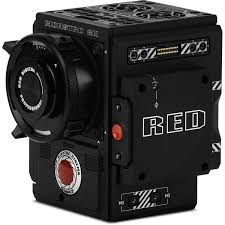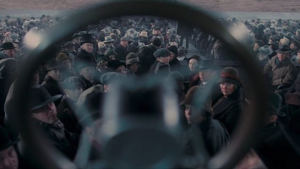Screenplay format refers to the content elements and on-page style of a script using a standard format by the film, television, and commercial industries.
Standard Screenplay Format:
- 12-point Courier Font
- 1.5 inch left margin
- 1-inch right margin (between 0.5 inches and 1.25 inches), ragged
- 1 inch top and bottom margins
- Around 55 lines per page regardless of paper size. This excludes the page number and spaces after it
- Actor parenthetical (wrylies) 3.1 inches from the left side of the page (1.6 from the margin)
- Dialogue speaker names (in all caps) 3.7 inches from the left side of the page (2.2 from the margin)
- Transitions are capitalized (sometimes important props, sounds, and camera movements)
- Dialogue 2.5 inches from the left side of the page (1.5 inches from margin)
- Page numbers:
- In the top right corner
- Flush to the right margin
- Half-inch from the top of the page
- Numbers should have a period after
- The first page is not numbered
- The title page is not numbered and does not count as page one
- The first page to have a number is the second page of the screenplay (the third sheet of paper including the title page), which is numbered 2
If you are looking for individual screenplay examples, here are 70+ screenplay examples from various movies.
Elements of Screenplay Format
Every script, no matter the writing or story genre, includes the same organizational parts. These elements help anyone who reads the screenplay to understand who’s talking or doing what when, where, and how. Here are the elements you should use to organize the content of your visual story:
Fade In
This is the starting point of every script. It’s when the figurative “curtain” lifts and the story begins. This transition phrase should only be used once at the very beginning of your script, right before the first scene heading or scene description paragraph. The phrase should be in all caps and end in a colon to indicate continuation as the story begins to unfold, as such — FADE IN:
If your story starts with a voice-over or a sound effect before the audience sees any visuals, you can begin the script with OVER BLACK, then write the character’s voice-over as CHARACTER NAME (V.O.) and the line or just write the sound effect in the action line. Once your story introduces a visual, that’s when you can use “FADE IN:” to officially begin.
Scene Heading
Also known as a “slug line,” the scene heading briefly describes where each scene takes place. It should be written in all caps and use periods and hyphens to properly segment each part, which are:
- General location: Decide whether the scene takes place inside or outside of the specific location. Use INT. (for interior) or EXT. (for exterior). This element helps establish the scene’s surroundings.
- Specific location: This is exactly where the scene takes place and where the camera is located in reference to the characters, which can help readers better visualize where they are as the audience when viewing the scene.
- Time of day: Include the time of day to help readers track the timeline of the story as well as better set the scene. The most commonly used times of day include DAY, NIGHT, EVENING, and the occasional LATER, which may be used to indicate that not much time has passed.
Here are a few examples:
- EXT. SAUCED HOG BIKER BAR – NIGHT
- INT. DRAB OFFICE – DAY
- EXT. GRAND CANYON – EVENING
- INT. MAGGIE’S GARAGE – LATER
Subheaders
Subheaders are like small slug lines that are more casual and explain when the scene occurs in another place or time (ex: Later, or Library).
Action Lines
Also referred to as scene descriptions, action lines are used to show readers what’s going on in a scene. This includes:
- Character description: When we first meet a character, you should briefly describe their qualities so readers can visualize what they look like, how they walk, and other physical — or even personality — traits. Upon first reference, write a character’s name in all caps.
- Scene description: Though an interchangeable term, scene description also refers to setting the scene. Briefly describe the look, feel, weather, and qualities of a setting so readers can clearly see where the story takes place.
- Character or object action: Show the reader what characters do with strong, precise, active verbs. Objects can complete actions, too, such as “The phone buzzes on the table.” If you’re introducing an important object or want to highlight an important action, you can write the object or action in all caps, like “The RING falls from his hand.” or “She POCKETS the diamond.”
Speaking Character
Every time a person speaks, whether on-screen or in voice-over, you should write their name in all caps and centered in the middle of the page. Typically, you can just use their first name or a nickname that captures their personality. Either way, make sure you introduce their name and/or nickname in the scene description earlier in the script and be consistent when labeling their dialogue and actions in the action lines.
Dialogue
This element goes under the all-caps-and-centered character name, centered and justified. Use standard capitalization and punctuation and make it double-spaced. If you want a character to emphasize a word or phrase, you can underline it. But use that sparingly so actors and directors have the freedom to play around with scenes.
Here’s a full example:
LILY
Why did you do that? I had this under control! You
never trust me.
Parenthetical
These are mini directions from a writer that clarify how a line is supposed to be read. For example:
TERRANCE
(defensive)
I trust you. I asked you to take my dog to the vet
last week.
Parentheticals are also used for extensions to indicate when a character is speaking off-screen (O.S.) or in voice-over (V.O.), such as:
MATT (O.S.)
Will you please stop shouting? I’m trying to sleep.
CARLY (V.O.)
Matt was always trying to sleep.
Other uses of parentheticals include:
- When characters are speaking into devices such as phones or radios (INTO DEVICE)
- When dialogue from the next scene starts before the current scene has ended (Pre-lap)
- When characters are performing actions while speaking (ex: Stretching, drawing, falling to his knees)
Shots
Specifying a particular type of shot (such as low-angle) is not very common, screenwriters only specify shots when it is critical to the scene.
Montage
Montages use a specific format:
- You first write “Begin Montage” as if it were a subheader
- List out your scenes as you normally would
- Stop the montage with “End Montage” as if it were a subheader
Lyrics
Lyrics in scripts are challenging since they take up a lot of page space, but don’t take much time to sing and each page of film script should equal roughly one minute of screen time. Typically writers either space out the lyrics with shots and actions or the general feel of the song is described versus writing out all words.
Chyrons
Text that appears over the screen to indicate the time and place to the audience (usually in spy or military movies). First, start an action line with the word “CHYRON” (or “TITLE”) followed by the text of the chyron.
Fade Out
This final transition indicates the end of your story. It’s written after the final action line or dialogue on the left-hand side, about 6 inches from the left edge of the page.
Spec Script vs. Shooting Script
The two types of scripts are the spec script and the shooting script. A spec script, or “speculative script,” is a screenplay, just the bare-bones outline of the visual story. A shooting script is an evolution on a spec that includes other details needed for production and post-production. These often include the following additional elements:
- Camera angles, like “CLOSE UP ON:” and “PAN DOWN TO:”
- Scene numbers to coordinate written scenes and their filmed counterparts
- Credits sequences, such as over an introductory montage
- Shooting location information
- Inserts, which are notes that the camera cuts to a specific image, such as “INSERT: PHOTOGRAPH”
- Transitions are typically reserved for post-production editing. Examples include:
- “CUT TO”: any transition that is not marked is assumed to be a cut
- “FADE TO”: a transition where the scene fades to another scene
- “SMASH TO”: a very abrupt cut, such as one that might come mid-sentence
- “DISSOLVE TO”: a scene that “dissolves” into another scene, usually indicating time has passed
- “MATCH CUT TO”: when the last shot in the previous scene (ex: hand reaching for a book) matches the first shot in a new scene (ex: a hand reaching for an apple)
- “INTERCUT”: when two scenes are bounced back and forth, usually for phone calls
These elements do not need to be in a spec script because a producer, director, or other production professionals will handle the decisions that become those additional details in the shooting script.
Tips for Properly Formatting Your Screenplay
Here are some additional tips to help you optimize the format of your screenplay:
- Use screenwriting software: Make formatting elements like spacing, indenting, and margins easy with software like Final Draft, Celtx, or WriterDuet. Not only do these programs let you simply cycle through properly formatted elements like character dialogue, but they also automatically set the 1.5-inch left margin and 1-inch top, bottom, and right margins. They also default to 12-point Courier font, the industry standard.
- Limit parenthetical phrases: These should be used sparingly so that actors and directors can convey the emotions they believe the characters are experiencing. Try to only use them if the line can be read in a way that contradicts the scene.
- Avoid unnecessary transitions: Though some seasoned professionals may use transitions like “CUT TO” between scenes, this small choice can actually impact a script’s readability. Stick with a new scene heading, which helps move the story along just fine.
- Split up large blocks of text: One page of screenplay roughly equals one minute of screen time, so optimizing the elements can ensure your page count more accurately reflects how long the filmed project is likely to be. Break up large blocks of text, such as action lines that go more than three or four lines on a page. For monologues, you can break them up with action lines that punctuate the character’s speech.
Another great way to develop your screenwriting skills and make industry-standard formatting second nature is to join a professional-quality writing course or program. The Nashville Film Institute can prepare you with all of the necessary technical and creative skills you need to be successful in the filmmaking industry.














